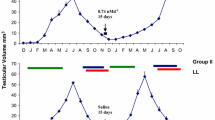Abstract
Three experimental protocols were employed to clarify whether the circadian system is involved in photoperiodic time-measurement in the blackheaded bunting, Emberiza melanocephala. In a single-pulse paradigm, one 8-h light pulse was delivered at different times to groups of birds across three days of constant darkness (DD). Photoperiodic induction, as measured by a rise in plasma luteinizing hormone (LH), showed clear circadian rhythmicity. The second experiment examined the LH responses in birds exposed to lighting cycles using a Nanda-Hamner type of protocol and confirmed full photostimulation under 6L:30D. The third experiment measured the time of the first photo-induced rise in LH in birds subjected to 30 h of continuous light following entrainment under short days (6L:18D). This experiment aimed to identify the position of the photoinducible phase (Φ i). LH first rose at hour 18 following dawn indicating that Φ i lies in the middle of the day. Plasma concentrations of melatonin were also measured under 6L:18D and 6L:30D light cycles as another physiological marker of the circadian system in buntings. The pattern of melatonin secretion under these LD cycles showed properties consistent with the driving oscillator being circadian in nature. It is concluded that the circadian pacemaker driving the photoinducible rhythm in blackheaded bunting is strongly self-sustaining and free-runs under constant conditions.
Similar content being viewed by others
References
Elliott JA (1976) Circadian rhythms and photoperiodic timemeasurement in mammals. Fed Proc 35: 2339–2346
Elliott JA, Stetson MH, Menaker M (1972) Regulation of testis function in golden hamster: a circadian clock measures photoperiodic time. Science 178: 771–773
Farner DS, Donham RS, Lewis RA, Mattocks PW Jr., Darden TR, Smith JP (1977) The circadian component in the photoperiodic mechanism of the house sparrow, Passer domesticus. Physiol Zool 50: 247–267
Foà A, Menaker M (1988) Contribution of pineal and retinae to the circadian rhythm of circulating melatonin in pigeons. J Comp Physiol A 164: 25–30
Follett BK, Pearce-Kelly AS (1991) Photoperiodic induction in quail as a function of the period of the light-dark cycle: implication for models of time measurement. J Biol Rhythms 6: 331–341
Follett BK, Scanes CG, Cunningham FJ (1972) A radioimmunoassay for avian luteinizing hormone. J Endocrinol 52: 359–378
Follett BK, Mattocks PW, Farner DS (1974) Circadian function in the photoperiodic induction of gonadotropin secretion in the white-crowned sparrows. Proc Natl Acad Sci USA 71: 1666–1669
Follett BK, Kumar V, Juss TS (1992) Circadian nature of photoperiodic clock in Japanese quail. J Comp Physiol A 171: 533–540
Fraser SB, Cowen P, Franklin M, Franey C, Arendt J (1983) Direct radioimmunoassay for melatonin in plasma. Clin Chem 29: 396–397
Hamner WM, Enright JT (1967) Relationships between photoperiodism and circadian rhythms of activity in the house finch. J Exp Biol 46: 43–61
Jainik D, Dittami JP, Gwinner E (1992) The effect of pinealectomy on circadian plasma melatonin levels in house sparrows and European starlings. J Biol Rhythms 7: 227–236
Juss TS, King VM, Kumar V, Follett BK (1995) Does unusual entrainment of the circadian system under T36 photocycles reduce the critical daylength for photoperiodic induction in Japanese quail? J Biol Rhythms 10: 17–32
King VM (1995) The circadian biology of Japanese quail and European starlings. PhD Thesis University of Bristol, Bristol, UK
Kumar V, Follett BK (1993) The circadian nature of melatonin secretion in Japanese quail (Coturnix coturnix japonica). J Pineal Res 14: 192–200
Kumar V, Jain N (1995) Circadian regulation of melatonin secretion in blackheaded bunting (Emberiza melanocephala). Indian J Exp Biol 33: 333–336
Kumar V, Kumar BS (1995) Entrainment of circadian system under variable photocycles (T-photocycles) alters the critical daylength for photoperiodic induction in blackheaded buntings. J Exp Zool 273: 297–302
Kumar V, Jain N, Singh BP, Kumar BS (1993) Plasma levels of luteinizing hormone in intact and castrated photosensitive blackheaded buntings (Emberiza melanocephala) exposed to stimulatory and non-stimulatory photoperiods. Reprod Nutr Dev 33: 143–150
Kumar V, Jain N, Singh BP (1994) Nature of circadian rhythm of photoperiodic photosensitivity in the blackheaded buntings (Emberiza melanocephala). Indian J Exp Biol 32: 789–792
Meddle SL, Follett BK (1995) Photoperiodic activation of Fos-like immunoreactive protein in neurons within the tuberal hypothalamus of Japanese quail. J Comp Physiol A 176: 79–89
Nanda KR, Hamner KC (1958) Studies on the nature of the endogenously rhythm affecting photoperiodic response of Bioloxi soybean. Bot Gaz (Chicago) 120: 14–25
Perera AD, Follett BK (1992) Photoperiodic induction in vitro: the dynamics of gonadotropin-releasing hormone release from hypothalamic expiants of the Japanese quail. Endocrinology 131: 2898–2908
Saiovici MS, Nicholls TJ, Follett BK (1987) Rapid photoperiodic responses in Japanese quail: Is daylength measurement based upon circadian system? J Biol Rhythms 2: 139–152
Saunders DS (1982) Insect clocks (2nd edn). Pergamon Press, Oxford, UK
Tewary PD, Kumar V (1981) Circadian periodicity and the initiation of gonadal growth in male blackheaded buntings (Emberiza melanocephala). J Comp Physiol B 144: 201–203
Tewary PD, Kumar V (1984) Control of testis function in the blackheaded bunting, Emberiza melanocephala. Current Sci 53: 113–114
Underwood H, Hyde LL (1990) A circadian clock measures photoperiodic time in the male lizard Anolis carolinensis. J Comp Physiol A 167: 231–243
Author information
Authors and Affiliations
Rights and permissions
About this article
Cite this article
Kumar, V., Jain, N. & Follett, B.K. The photoperiodic clock in blackheaded buntings (Emberiza melanocephala) is mediated by a self-sustaining circadian system. J Comp Physiol A 179, 59–64 (1996). https://doi.org/10.1007/BF00193434
Accepted:
Issue Date:
DOI: https://doi.org/10.1007/BF00193434



